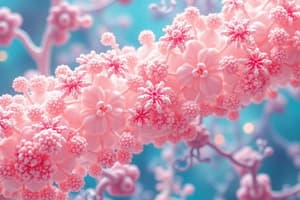Podcast
Questions and Answers
What is the main energy source that drives translocation in the Tat system?
What is the main energy source that drives translocation in the Tat system?
- Proton Motive Force (PMF) (correct)
- ATP hydrolysis
- Oxidative phosphorylation
- GTP hydrolysis
How do Tat systems translocate proteins across biological membranes?
How do Tat systems translocate proteins across biological membranes?
- By unfolding the proteins before translocation
- By creating a proton gradient in the cytoplasm
- By translocating folded proteins (correct)
- By utilizing ATP hydrolysis
What is the primary function of the Tat system in translocating proteins?
What is the primary function of the Tat system in translocating proteins?
- To transport proteins that have already folded (correct)
- To maintain osmotic balance within the cell
- To transport only unfolded proteins
- To generate ATP for cellular processes
How does the function of the Tat system differ from the Sec system?
How does the function of the Tat system differ from the Sec system?
What type of proteins are translocated by the Tat system?
What type of proteins are translocated by the Tat system?
What happens to the signal sequence after it inserts into the membrane during protein translocation?
What happens to the signal sequence after it inserts into the membrane during protein translocation?
What term is used for Sec-transported proteins before the signal sequence is cleaved?
What term is used for Sec-transported proteins before the signal sequence is cleaved?
Which type of proteins become anchored in the inner membrane when containing a hydrophobic sequence long enough to span the membrane thickness?
Which type of proteins become anchored in the inner membrane when containing a hydrophobic sequence long enough to span the membrane thickness?
What is the role of an accessory protein in the translocation of integral membrane proteins?
What is the role of an accessory protein in the translocation of integral membrane proteins?
What happens to a protein with a sufficient hydrophobic sequence to span the membrane thickness during translocation?
What happens to a protein with a sufficient hydrophobic sequence to span the membrane thickness during translocation?
When does a preprotein transform into a mature protein during translocation of integral membrane proteins?
When does a preprotein transform into a mature protein during translocation of integral membrane proteins?
What is the major pathway for the integration of proteins into the inner membrane in Gram-negative bacteria?
What is the major pathway for the integration of proteins into the inner membrane in Gram-negative bacteria?
Which of the following tags is carried by Sec-targeted proteins?
Which of the following tags is carried by Sec-targeted proteins?
According to the positive-inside rule, where are the (+) charged residues adjacent to a hydrophobic α-helix located?
According to the positive-inside rule, where are the (+) charged residues adjacent to a hydrophobic α-helix located?
Which translocator system is responsible for translocating proteins through the inner membrane in Gram-positive bacteria?
Which translocator system is responsible for translocating proteins through the inner membrane in Gram-positive bacteria?
What does the Sec-targeted protein carry as an N-terminal tag?
What does the Sec-targeted protein carry as an N-terminal tag?
What method is used to determine the mechanism of translocator function?
What method is used to determine the mechanism of translocator function?




